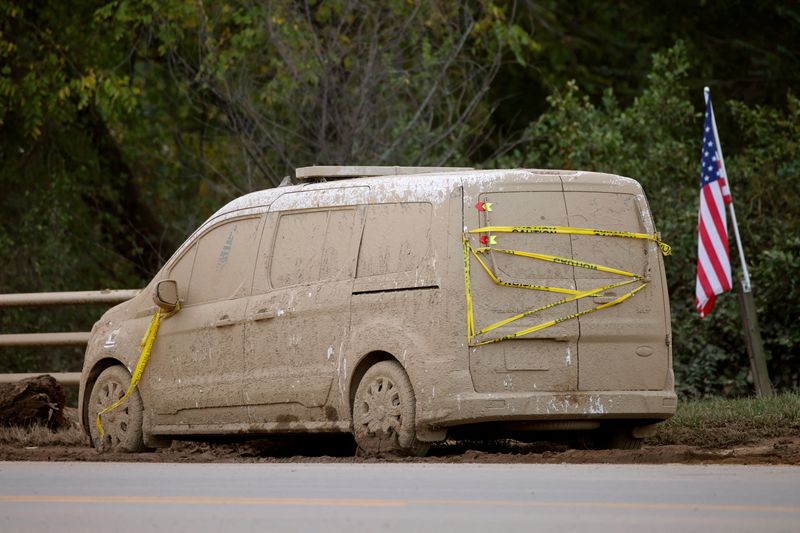Helene storm survivors piece lives back together as Biden, Harris due to visit
2024.10.02 11:37
By Bernie Woodall
ASHEVILLE, North Carolina (Reuters) -Survivors of Helene struggled to piece their lives back together as President Joe Biden and Vice President Kamala Harris planned to survey damage on Wednesday from the storm that killed at least 162 people following its rampage through the U.S. Southeast.
Many residents in the western Carolinas had no running water, nearly a week after Helene came ashore in Florida as a major Category 4 hurricane. About 1.2 million homes and businesses remained without power in Georgia and the Carolinas on Wednesday, according to Poweroutage.us.
Biden is due to visit North and South Carolina, including an aerial tour of Asheville, the seat of North Carolina’s Buncombe County, where at least 57 people died.
Harris, in the middle of a presidential campaign against Republican former President Donald Trump, will travel to Georgia on Wednesday and North Carolina later in the week, two of the hardest-hit states. They also happen to be among seven key battleground states in this year’s election. Trump visited Georgia on Monday.
The high-profile visits come as federal, state and local officials are bracing for what U.S. Homeland Security Secretary Alejandro Mayorkas said would be a “multibillion-dollar undertaking” lasting years.
Helene came ashore in Florida late on Thursday before turning its fury on much of the U.S. Southeast, including Georgia and the Carolinas, as flash flooding tore through creeks and rivers, destroyed homes, and ripped victims away from their families.
For now, search-and-rescue teams continued to comb through the wreckage for people still unaccounted for and deliver aid amid washed-out roads, smashed bridges and felled power lines.
In the town of Swannanoa, Jessica Dixon, 40, said she believes her father was swept away to his death by the raging torrent in a creek behind their home.
“Dad went to the back to grab my mom’s purse where the keys were attached,” Dixon said. “Then, all I could hear was Parker (her son) saying, ‘Grandpa’s gone. Grandpa’s gone.’ And he was washed away.”
In Clyde, North Carolina, Matt Hartwiger evacuated his riverside home at 5:30 a.m. on Friday when the flood sirens wailed. Within hours water from the Pigeon River was up to the second floor.
Hartwiger, his wife, who is six months pregnant, their three young children and pets were among the first to reach the town’s shelter in Haywood County. They bounced around motels until journeying to Knoxville, Tennessee, a 65-mile (100-km) trip that took two days due to road closures.
Since then, a church group called him to say they were cleaning mud out of his home, which was built in 1900, and were piling destroyed furniture outside.
He plans to return.
“I don’t know if there’ll be work. I don’t know if people will have places to live,” said Hartwiger, a restaurant manager.
Asheville resident Rachel Simpson considers herself lucky to have weathered the storm with only minor damage to her home, after many houses in the area were destroyed by raging floodwaters.
But Simpson, 33, said it has been difficult with no water to bathe, wash clothes or flush toilets. She filled her bathtub the night before the storm, but the water is running low.
“The city says it’ll be at least four weeks before the water comes back on,” she said. “Right now we’re getting by the best we can. All the water we have now we’re getting from friends.”
“Right now, we just don’t know, but we’re working together,” she said.
Harrison Fahrer, 37, co-founder of the west Asheville brew house Cellarest Beer Project, knows his problems pale compared with those of people whose houses and businesses didn’t survive. But he’s not sure how he’ll make it through the aftermath.
“You turn on the spigot and all it does is hiss,” he said. “We have no water. We can’t brew. If we can’t brew, we can’t pay our bills, our loans, our rent, utilities.”
Fahrer said he knew the storm was coming, but he shrugged it off. Hurricanes don’t hit Asheville, he thought; the storms lose power and just drop some rain.
“No one could have fathomed the storm would be like this,” he said. “It washed so much of the city away.”
Some locations of western North Carolina may have experienced a 5,000-year event, so perfect were conditions to create maximum precipitation, said Tennessee state climatologist Andrew Joyner.

A storm before Helene sucked moisture from the Gulf of Mexico and saturated areas like Mount Mitchell, which at 6,684 feet (2,037 meters) is the highest point in the Appalachian Mountains, above hard-hit communities like Swannanoa and Black Mountain. Then Helene approached at the perfect angle to rise over the peak, intensifying rainfall.
“The event was a perfect storm,” Joyner said.








